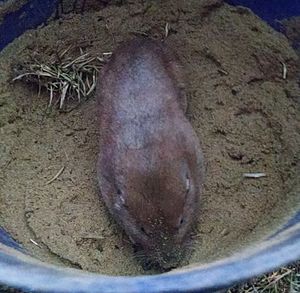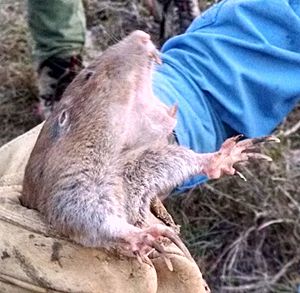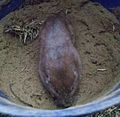Southeastern pocket gopher facts for kids
The southeastern pocket gopher (Geomys pinetis) is a small animal that lives underground. It's a type of pocket gopher found only in the southeastern parts of the United States. You can find it in states like Alabama, Georgia, and Florida. In these states, it's the only kind of pocket gopher you'll see.
Quick facts for kids Southeastern pocket gopher |
|
|---|---|
 |
|
| Conservation status | |
| Scientific classification | |
| Genus: |
Geomys
|
| Species: |
pinetis
|
| Subspecies | |
|
G. p. austrinus |
|
Contents
What Does a Southeastern Pocket Gopher Look Like?
The southeastern pocket gopher is smaller than its cousin, the plains pocket gopher. It measures about 260 mm (10.2 in) long, including its tail, which is about 86 mm (3.4 in). Male gophers are usually bigger than females. Males weigh around 176 g (6.2 oz), while females weigh about 136 g (4.8 oz).
Their fur on their back is a cinnamon brown color. Their belly fur is lighter, often a pale yellow or reddish-yellow. Their feet and tail are white or light yellow. Like other pocket gophers, they have special external cheek pouches. These pouches can be turned inside-out, which helps them clean the pouches. They are built for living underground. They have large, strong incisor teeth that stick out, which they use to tear roots. Their front paws have powerful claws, perfect for digging tunnels.
Where Do Southeastern Pocket Gophers Live?
This gopher lives only in the southeastern part of the United States. You can find it in Alabama, Georgia, and Florida. It likes to live in dry, sandy places. These include sand-hill areas with longleaf pine trees (Pinus palustris) and turkey oak trees (Quercus laevis).
They also live in slightly wetter areas called hammocks. These are low mounds among the sand-hills, often with Quercus virginiana and other hardwood trees. Away from the sand dunes, they live in longleaf pine forests and scrubby areas with sand pine trees (Pinus clausa). You can easily tell if gophers are in an area because of the many piles of sand they push to the surface.
How Do Southeastern Pocket Gophers Live?
Southeastern pocket gophers are solitary animals. This means they live alone. Each gopher digs its own system of tunnels. They create shallow tunnels near the surface. Above these tunnels, you'll see fan-shaped mounds of sand. The gopher pushes the soil up with its front legs and chest. It then quickly blocks the tunnel entrance with soil.
These shallow tunnels connect to deeper tunnels. A spiral "staircase" leads down to these deeper parts. Down below, they have special rooms for storing food. They also have a nest chamber, which might be lined with dried plants and fibers.
Reproduction and Life Cycle
Southeastern pocket gophers usually have babies in the spring and summer. The busiest times for breeding are around February/March and June/July. A mother gopher is pregnant for about four weeks. On average, she will have two babies at a time. Even though they don't have many babies, these gophers are common. This suggests that most of their young survive and grow up.
Sometimes, gophers come above ground. We know this because they eat green plants. Also, owls sometimes catch and eat them. However, there are not many predators underground. The main dangers to gophers in their tunnels are snakes and weasels.
What Do Southeastern Pocket Gophers Eat?
These gophers are active all year long. They mostly eat roots and rhizomes (underground stems) that they find in their tunnels. They also eat green plants like grasses, sedges, and weeds. They can reach these plants from near the entrance of their burrows. They collect a lot of plants and carry them back to their food storage rooms underground.
Many small creatures, called arthropods, share the gophers' burrows. About fourteen types of these arthropods are found nowhere else! Southeastern pocket gophers are sometimes attracted to farms. They especially like sweet potato crops. They can also be a pest to peanut and pea crops, and even sugarcane fields.
Images for kids
- Patton, J. L. (2005). "Geomys pinetis". In Wilson, D. E.; Reeder, D. M.. Mammal Species of the World: A Taxonomic and Geographic Reference (3rd ed.). Johns Hopkins University Press. p. 863. ISBN 978-0-8018-8221-0. OCLC 62265494. http://www.departments.bucknell.edu/biology/resources/msw3/browse.asp?id=12800083.





